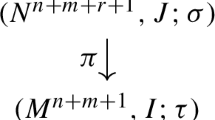Abstract
Recent findings concerning the zeros of generic polynomials are extended to entire functions featuring infinitely many distinct zeros, and related systems of infinitely many nonlinearly coupled evolution ODEs and PDEs are identified, the solutions of which display interesting properties.
Similar content being viewed by others
References
F. Calogero, “New solvable variants of the goldfish many–body problem,” Stud. Appl. Math., 137, 123–139 (2016).
O. Bihun and F. Calogero, “A new solvable many–body problem of goldfish type,” J. Nonlinear Math. Phys., 23, 28–46 (2016)
“Novel solvable many–body problems,” J. Nonlinear Math. Phys., 23, 190–212 (2016)
“Generations of monic polynomials such that the coefficients of each polynomials of the next generation coincide with the zeros of polynomial of the current generation, and new solvable many–body problems,” Lett. Math. Phys., 106, 1011–1031 (2016)
“Generations of solvable discrete–time dynamical systems,” J. Math. Phys., 58, 052701 (2017).
F. Calogero, “A solvable N–body problem of goldfish type featuring N2 arbitrary coupling constants,” J. Nonlinear Math. Phys., 23, 300–305 (2016)
“Three new classes of solvable N–body problems of goldfish type with many arbitrary coupling constants,” Symmetry, 8, 53 (2016).
“Novel isochronous N–body problems featuring N arbitrary rational coupling constants,” J. Math. Phys., 57, 072901 (2016).
“Yet another class of new solvable N–body problems of goldfish type,” Qual. Theory Dyn. Syst., 16, 561–577 (2017)
“New solvable dynamical systems,” J. Nonlinear Math. Phys., 23, 486–493 (2016)
“Integrable Hamiltonian N–body problems in the plane featuring N arbitrary functions,” J. Nonlinear Math. Phys., 24, 1–6 (2017)
“New C–integrable and S–integrable systems of nonlinear partial differential equations,” J. Nonlinear Math. Phys., 24, 142–148 (2017)
M. Bruschi and F. Calogero, “A convenient expression of the time–derivative z(k) n (t), of arbitrary order k, of the zero zn(t) of a time–dependent polynomial pN(z; t) of arbitrary degree N in z, and solvable dynamical systems,” J. Nonlinear Math. Phys., 23, 474–485 (2016).
F. Calogero, Zeros of Polynomials and Solvable Nonlinear Evolution Equations, Cambridge Univ. Press, Cambridge (2018).
F. Calogero, “Nonlinear differential algorithm to compute all the zeros of a generic polynomial,” J. Math. Phys., 57, 083508 (2016). Erratum, 57, 104101 (2016). arXiv:1607.05081v1 [math.CA] (2016).
F. Calogero, “Novel differential algorithm to evaluate all the zeros of any generic polynomial,” J. Nonlinear Math. Phys., 24, 469–472 (2017).
H. Davenport, Multiplicative Number Theory (Lect. Adv. Math., Vol. 1), Markham, Chicago (1967).
F. Calogero, “The neatest many–body problem amenable to exact treatments (a ‘goldfish’ ?),” Phys. D, 152–153, 78–84 (2001).
F. Calogero, “Motion of poles and zeros of special solutions of nonlinear and linear partial differential equations, and related ‘solvable’ many body problems,” Nuovo Cimento B, 43, 177–241 (1978); Classical Many–Body Problems Amenable to Exact Treatments (Lect. Notes Phys. New Series m: Monogr., Vol. 66), Springer, Berlin (2001).
F. Calogero, Isochronous Systems, Oxford Univ. Press, Oxford (2012).
F. Calogero and D. Gómez–Ullate, “Asymptotically isochronous systems,” J. Nonlinear Math. Phys., 15, 410–426 (2008).
D. Gómez–Ullate and M. Sommacal, “Periods of the goldfish many–body problem,” J. Nonlinear Math. Phys., 12, Supp. 1, 351–362 (2005).
E. Martínez Alonso and A. B. Shabat, “Energy–dependent potentials revisited: A universal hierarchy of hydrodynamic type,” Phys. Lett. A, 300, 58–64 (2002)
V. E. Adler and A. B. Shabat, “Model equation of the theory of solitons,” Theor. Math. Phys., 153, 1373–1387 (2007)
A. B. Shabat, “Symmetric polynomials and conservation laws [in Russian],” Vladikavkaz. Mat. Zh., 14, No. 4, 83–94 (2012).
G. Gallavotti and C. Marchioro, “On the calculation of an integral,” J. Math. Anal. Appl., 44, 661–675 (1973).
E. Bombieri, Problems of the Millennium: The Riemann Hypothesis, Clay Mathematics Institute, Cambridge, Mass. (2000).
H. M. Edwards, Riemann’s Zeta Function (Pure Appl. Math., Vol. 58), Acad. Press, New York (1974).
Author information
Authors and Affiliations
Corresponding author
Additional information
Prepared from an English manuscript submitted by the author; for the Russian version, see Teoreticheskaya i Matematicheskaya Fizika, Vol. 196, No. 2, pp. 193–214, August, 2018.
Rights and permissions
About this article
Cite this article
Calogero, F. Zeros of Entire Functions and Related Systems of Infinitely Many Nonlinearly Coupled Evolution Equations. Theor Math Phys 196, 1111–1128 (2018). https://doi.org/10.1134/S0040577918080020
Published:
Issue Date:
DOI: https://doi.org/10.1134/S0040577918080020




